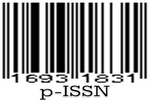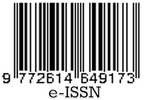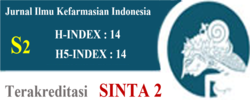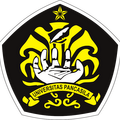The Latest Research on 3 (Three) Types of Sea Cucumber Extract from Tegal Mas Island, Lampung
Abstract
Sea cucumbers are deep-sea-dwelling invertebrate animals that are rich in nutrients and have been empirically used to prevent various degenerative diseases, especially due to their ability to dampen free radicals. The purpose of this study was to identify, and determine antioxidant activity, total phenolic content, and toxic properties in extracts of several sea cucumber species originating from Tegal Mas Island, Lampung. The identification results of the three sea cucumber species were Stichopus vastus Sluiter (SV), Stichopus monotuberculatus Quay & Gaimard (SM), and Stichopus quadrifasciatus Massin. (SQ). The extraction was performed by kinetic maceration against all parts of the sea cucumber using a 70% ethanol solvent. Antioxidant activity test using the DPPH (2,2-diphenylpicrilhydrazyl) free radical suppression method and determination of the total phenolic content using the Folin-Ciocalteu method. The results showed that SV had the highest total phenolics and antioxidants with the lowest toxicity. However, optimisation of extraction between wet and dry sea cucumbers is still required. Extraction optimisation with various solvents can also be done to gain secondary metabolites more effectively.
References
2. Martemucci G, Costagliola C, Mariano M, D’andrea L, Napolitano P, D’Alessandro AG. Free radical properties, source and targets, antioxidant consumption and health. Oxygen. 2022 Apr 12;2(2):48-78.
3. Pangestuti R, Arifin Z. Medicinal and health benefit effects of functional sea cucumbers. Journal of traditional and complementary medicine. 2018 Jul 1;8(3):341-51.
4. Soltani M, Parivar K, Baharara J, Kerachian MA, Asili J. Hemolytic and cytotoxic properties of saponin purified from Holothuria leucospilota sea cucumber. Reports Biochem Mol Biol 2014;3(1):43–50.
5. Rasyid A. Identification of secondary metabolites compounds antibacterial and antioxidant activities on the methanol extract of sea cucumber Stihopus hermanii. J Ilmu dan Teknol Kelaut Trop 2012;4(2):360–8.
6. Nobsathian S, Tuchinda P, Sobhon P, Tinikul Y, Poljaroen J, Tinikul R, et al. An antioxidant activity of the whole body of Holothuria scabra. Chem Biol Technol Agric 2017;4(1):17–21.
7. Chasanah E, Fawzya YN, Tarman K, Januar HI, Nursid M. Fatty acid profile, carotenoid content, and in vitro anticancer activity of Karimunjawa and Lampung sea cucumber. Squalen Bull Mar Fish Postharvest Biotechnol 2016;11(3):117-24
8. Directorate General of Pharmaceutical and Medical Devices Pharmacopoeias Formularies Herbal Medicine (II. ed.), Ministry of Health Republic Indonesia, Jakarta (2017).
9. Martemucci G, Costagliola C, Mariano M, D’andrea L, Napolitano P, D’Alessandro AG. Free radical properties, source and targets, antioxidant consumption and health. Oxygen. 2022;2(2):48-78.
10. Ramadhan H, Purnama S, Sayakti PI. Antioxidant activity assay from n-hexane fraction of Binjai Mangifera caesia Jack. ex. wall. leaves methanolic extract using DPPH method. J Ilmu Kefarmasian Indones 2022;20(1):55–62.
11. Olszowy M. What is responsible for antioxidant properties of polyphenolic compounds from plants?. Plant Physiology and Biochemistry. 2019;144:135-43.
12. Yangthong M, Hutadilok-Towatana N, Phromkunthong W. Antioxidant activities of four edible seaweeds from the Southern Coast of Thailand. Plant Foods Hum Nutr 2009;64(3):218–23.
13. Hamidi MR, Jovanova B, Panovska TK. Toxicological evaluation of the plant products using brine shrimp (Artemia salina L.) model. Macedonian pharmaceutical bulletin. 2014;60(1):9-18.
14. Carballo JL, Hernández-Inda ZL, Pérez P, García- Grávalos MD. A comparison between two brine shrimp assays to detect in vitro cytotoxicity in marine natural products. BMC Biotechnol 2002;2:1–5.
15. Handayani SN, Bawono LC, Ayu DP, Pratiwi HN. Isolation of polifenol black garlic and toxicity assay toward Artemia salina Leach. J Ilmu Kefarmasian Indones 2018;16(2):145–9.
16. Rocha RP, Melo EC, Radünz LL. Influence of drying process on the quality of medicinal plants: A review. Journal of Medicinal Plants Research. 2011;5(33):7076-84.
17. Leha MA, Retraubun AS, Moniharapon T, Simanjuntak P. Cytotoxicity of several types of sea cucumbers from Seira Island and Luang Island. Maj Biam 2020;16(1):45–51.
18. Laksana A. Parameter standar umum ekstrak tumbuhan obat : Direktorat Jenderal Pengawasan Obat dan Makanan. Departemen Kesehatan. Jakarta: Jakarta Departemen Kesehatan; 2000.
19. Arifin HN, Ningsih R, Fitrianingsih AA, Hakim A. Antibacterial activity test sea cucumber extract (Holothuria scabra) Sidayu Coast Gresik using disk diffusion method. Alchemy 2013;2(2):101–6.
20. Sukmiwati M, Diharmi A, Mora E, Susanti E. Aktivitas antimikroba teripang kasur (Stichopus vastus Sluiter) dari perairan Natuna Kepulauan Riau. JPHPI. 2018;21:328–35.
21. Murniasih T, Putra M, Pangestuti R, Pasir J, Timur A. Antioxidant capacities of Holothuria sea cucumbers. Ann Bogor 2015;19(2):21–6.
22. Jha RK, Zi-Rong X. Biomedical compounds from marine organisms. Mar Drugs 2004;2(3):123–46.
23. Mamelona J, Pelletier É, Girard-Lalancette K, Legault J, Karboune S, Kermasha S. Quantification of phenolic contents and antioxidant capacity of Atlantic sea cucumber, Cucumaria frondosa. Food Chem. 2007;104(3):1040–7.
24. Fitriansyah S, Fidrianny I, Ruslan K. Correlation of Total phenolic, flavonoid and carotenoid content of Sesbania sesban (L. Merr) leaves extract with DPPH scavenging activties. Int J Pharmacogn Phytochem Res 2017;9(1):89-94.
25. Machu L, Misurcova L, Ambrozova JV, Orsavova J, Mlcek J, Sochor J, et al. Phenolic content and antioxidant capacity in algal food products. Molecules 2015;20(1):1118–33.
26. Elvevoll EO, James D, Toppe J, Gamarro EG, Jensen IJ. Food safety risks posed by heavy metals and persistent organic pollutants

This work is licensed under a Creative Commons Attribution-NonCommercial-ShareAlike 4.0 International License.
Licencing
All articles in Jurnal Ilmu Kefarmasian Indonesia are an open-access article, distributed under the terms of the Creative Commons Attribution-NonCommercial-ShareAlike 4.0 International License which permits unrestricted non-commercial used, distribution and reproduction in any medium.
This licence applies to Author(s) and Public Reader means that the users mays :
- SHARE:
copy and redistribute the article in any medium or format - ADAPT:
remix, transform, and build upon the article (eg.: to produce a new research work and, possibly, a new publication) - ALIKE:
If you remix, transform, or build upon the article, you must distribute your contributions under the same license as the original. - NO ADDITIONAL RESTRICTIONS:
You may not apply legal terms or technological measures that legally restrict others from doing anything the license permits.
It does however mean that when you use it you must:
- ATTRIBUTION: You must give appropriate credit to both the Author(s) and the journal, provide a link to the license, and indicate if changes were made. You may do so in any reasonable manner, but not in any way that suggests the licensor endorses you or your use.
You may not:
- NONCOMMERCIAL: You may not use the article for commercial purposes.
This work is licensed under a Creative Commons Attribution-NonCommercial-ShareAlike 4.0 International License.





 Tools
Tools





















